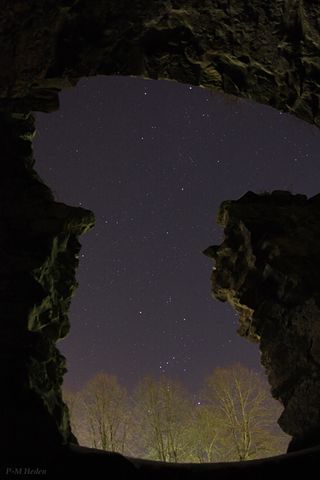
History and mythology combined to create this stunning photo of Orion seen through the ruins of an old Viking church in Sweden.
Taken by skywatcher Per-Magnus Heden, the photo shows the constellation Orion behind and atop the trees from the ruins, which resemble a face in profile.
"Being at historical sights, as the location in the photo, is something I love to do," The World At Night (TWAN) astrophotographer wrote in an email.
Orion is one of the most recognizable constellations in the sky for its likeness to a hunter with a bow and arrow. The name refers to a huntsman in Greek mythology whom Zeus placed among the stars to honor him after death.
Orion is visible in the night sky every year from November to February. Two of the brightest stars in the evening sky lie at opposite corners of Orion. Bright red Betelgeuse lies at the northeastern corner and even brighter Rigel lies at the southwest.
Near the center of the rectangle shape formed by the stars, look for a short diagonal line of three stars — this is called Orion's belt. And extending south from the belt, you'll see another, fainter line of stars that forms Orion's sword.
Higher above in the image is the constellation Auriga. Auriga is known as the celestial charioteer but has neither a chariot nor a horse. Instead, he is drawn in mythology as a man holding the reins in his right hand, with a goat on his left shoulder and two baby goats in his left arm. Look for him in the southern sky in January and February.
Auriga has a bright star called Capella, visible in the image. Capella is one of the few bright stars that appears yellow, like our sun. Both of these bright stars have roughly the same surface temperature.
The history of the area and the ancient stars inspired Heden to take this photo.
"The face from the wall of the church ruin seems to look at the same direction like I did during the photography and I do wonder how the sky looked like for a 1000 years ago when they built the church, " Heden wrote.
Editor's note: If you have an amazing skywatching photo you'd like to share for a possible story or image gallery, please contact managing editor Tariq Malik at tmalik@space.com.
Follow SPACE.com for the latest in space science and exploration news on Twitter @Spacedotcom and on Facebook.
Get the Space.com Newsletter
Breaking space news, the latest updates on rocket launches, skywatching events and more!
Join our Space Forums to keep talking space on the latest missions, night sky and more! And if you have a news tip, correction or comment, let us know at: community@space.com.
Nina Sen is a freelance writer and producer who covered night sky photography and astronomy for Space.com. She began writing and producing content for Space.com in 2011 with a focus on story and image production, as well as amazing space photos captured by NASA telescopes and other missions. Her work also includes coverage of amazing images by astrophotographers that showcase the night sky's beauty.
